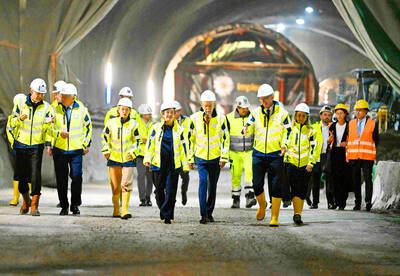The commencement of direct "three small links" between Taiwan's outlying islands and the Chinese coast yesterday may appear to offer the people of Matsu a golden opportunity to bolster the faltering economy on the tiny archipeligo.
But the limited scope of the exchanges and the likelihood of comprehensive direct links between Taiwan proper and China brought by the looming entry of both sides of the strait into the WTO may mean that the economic benefits to Matsu may well be short lived.
At the ceremony held yesterday at Matsu's main port of Fuao to mark the opening of the links Tsao Erh-chung (
In the initial stages, only simple commercial exchanges between and travel by residents -- or people who can prove they have lived there for at least six months -- of Kinmen and Matsu and the Chinese coastal cities of Xiamen and Mawei, respectively.
Tsao said that for the plan to "truly benefit the local economy, Mastu should be permitted to serve as a midway station for the trade of goods between Taiwan and China."
This proposal was formally forwarded in writing by the Matsu local government to Cabinet secretary-general Chiou I-jen, (
Chiou was cool on the suggestion saying the Cabinet would not allow goods from China to be exported to Taiwan via Matsu and only "consider" the possibility of allowing goods to flow the other way via the tiny isle that lies only 9km off China's coast.
However talk of transforming Matsu into a midway trade station may prove to be purely academic.
Vice chairman of the Mainland Affairs Council Chen Ming-tung (
Direct "big links" between Taiwan proper and China would negate the need for goods to travel across the strait via a third port such as Hong Kong or, if was permitted, Matsu.
Indeed, locals fear that once the "big links" are in place, Matsu and Kinmen will have served their purpose as a test case for direct ties and their commercial prospects in the grand scheme of China and Taiwan will diminish.
"Matsu people ask themselves that if the small links work well and both sides agree to the big three links, what will happen to Matsu?" said Yu Hsin-tai (
"Once big three links are opened any benefits of small links will die," he said.
Hopes that Matsu may be able to siphon off some financial gain from serving as a midway trade station are fueled by the fact that the economy's two major pillars -- fish and soldiers -- are becoming increasingly rare.
The number of troops in Matsu have been cut by 40 percent over the last two years as tensions across the strait eased and have dropped to 3,000 down from the 20,000 that resided here during the peak of cross strait tension in the 1950s and 1960s.
In the past, their patronage of local businesses ensured that virtually every household on Matsu was financially stable, according to Yu.
"The presence of one soldier here is enough to support four families," Yu said. "Their reduced numbers means that profits of local businesses have been cutting into the profits of local businesses," he said.
Adding to this, competition from Chinese fishermen in the waters around Matsu have reduced the numbers of local fishermen.
Of the 800 registered fishermen in his association only 200 to300 now fish professionally and their numbers may drop further as Chinese fishermen are permitted under the "small three links" plan to sell their catch in Matsu.
As for Taiwan fishermen doing likewise in Chinese ports, local business people say that the formally illegal trade with China in fish and other goods has gone on for years and the new regulations that accompany its decriminalization serve only as an inconvenience.
Besides direct trade, the links scheme also allows 100 Chinese people to visit Matsu and 700 Taiwanese to travel to China daily, which it is hoped will provide a boost to the local tourist industry.
Legislator Tsao urged the government to promote more public infrastructure projects especially in the area of tourism, which according to others on the island has been sorely lacking.
Transportation infrastructure hasn't been adequately developed, Yu said, citing the slow expansion of Matsu's only airport on the northern Peikan island and the yet-to-be-completed airport on the main southern island of Nankan.
Travel to Nankan still requires catching a plane to Peikan and then a 20-minute boat ride, which is susceptible to cancellation due to rough weather.
And although picturesque in places, Matsu's small size and beaches that remain guarded by soldiers and barbed wire reduce the island's attraction to those only curious about the island's role as the vanguard of Taiwan's defense for the last 52 years.
An elderly women who gave her name as Mrs Chang and who operates a small restaurant on one of the island's main business strips said Matsu's potential for tourism wasn't good, declaring that any tourist that came once would certainly never come again.
Implementation of "the small three links will likely see a rise in tourists going from here to China, but not the other way. What is there to do and buy here?" she said.

CHIP RACE: Three years of overbroad export controls drove foreign competitors to pursue their own AI chips, and ‘cost US taxpayers billions of dollars,’ Nvidia said China has figured out the US strategy for allowing it to buy Nvidia Corp’s H200s and is rejecting the artificial intelligence (AI) chip in favor of domestically developed semiconductors, White House AI adviser David Sacks said, citing news reports. US President Donald Trump on Monday said that he would allow shipments of Nvidia’s H200 chips to China, part of an administration effort backed by Sacks to challenge Chinese tech champions such as Huawei Technologies Co (華為) by bringing US competition to their home market. On Friday, Sacks signaled that he was uncertain about whether that approach would work. “They’re rejecting our chips,” Sacks

NATIONAL SECURITY: Intel’s testing of ACM tools despite US government control ‘highlights egregious gaps in US technology protection policies,’ a former official said Chipmaker Intel Corp has tested chipmaking tools this year from a toolmaker with deep roots in China and two overseas units that were targeted by US sanctions, according to two sources with direct knowledge of the matter. Intel, which fended off calls for its CEO’s resignation from US President Donald Trump in August over his alleged ties to China, got the tools from ACM Research Inc, a Fremont, California-based producer of chipmaking equipment. Two of ACM’s units, based in Shanghai and South Korea, were among a number of firms barred last year from receiving US technology over claims they have

It is challenging to build infrastructure in much of Europe. Constrained budgets and polarized politics tend to undermine long-term projects, forcing officials to react to emergencies rather than plan for the future. Not in Austria. Today, the country is to officially open its Koralmbahn tunnel, the 5.9 billion euro (US$6.9 billion) centerpiece of a groundbreaking new railway that will eventually run from Poland’s Baltic coast to the Adriatic Sea, transforming travel within Austria and positioning the Alpine nation at the forefront of logistics in Europe. “It is Austria’s biggest socio-economic experiment in over a century,” said Eric Kirschner, an economist at Graz-based Joanneum

BUBBLE? Only a handful of companies are seeing rapid revenue growth and higher valuations, and it is not enough to call the AI trend a transformation, an analyst said Artificial intelligence (AI) is entering a more challenging phase next year as companies move beyond experimentation and begin demanding clear financial returns from a technology that has delivered big gains to only a small group of early adopters, PricewaterhouseCoopers (PwC) Taiwan said yesterday. Most organizations have been able to justify AI investments through cost recovery or modest efficiency gains, but few have achieved meaningful revenue growth or long-term competitive advantage, the consultancy said in its 2026 AI Business Predictions report. This growing performance gap is forcing executives to reconsider how AI is deployed across their organizations, it said. “Many companies